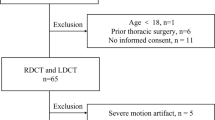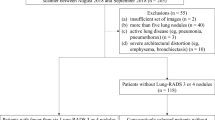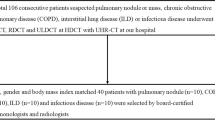Abstract
Objective
To compare the image quality between the vendor-agnostic and vendor-specific algorithms on ultralow-dose chest CT.
Methods
Vendor-agnostic deep learning post-processing model (DLM), vendor-specific deep learning image reconstruction (DLIR, high level), and adaptive statistical iterative reconstruction (ASiR, 70%) algorithms were employed. One hundred consecutive ultralow-dose noncontrast CT scans (CTDIvol; mean, 0.33 ± 0.056 mGy) were reconstructed with five algorithms: DLM-stnd (standard kernel), DLM-shrp (sharp kernel), DLIR, ASiR-stnd, and ASiR-shrp. Three thoracic radiologists blinded to the reconstruction algorithms reviewed five sets of 100 images and assessed subjective noise, spatial resolution, distortion artifact, and overall image quality. They selected the most preferred algorithm among five image sets for each case. Image noise and signal-to-noise ratio were measured. Edge-rise-distance was measured at a pulmonary vessel, i.e., the distance between two points where attenuation was 10% and 90% of maximal intravascular intensity. The skewness of attenuation was calculated in homogeneous areas.
Results
DLM-stnd, followed by DLIR, showed the best subjective noise on both lung and mediastinal windows, while DLIR yielded the least measured noise (ps < .0001). Compared to DLM-stnd, DLIR showed inferior subjective spatial resolution on lung window and higher edge-rise-distance (ps < .0001). Additionally, DLIR showed the most frequent distortion artifacts and deviated skewness (ps < .0001). DLM-stnd scored the best overall image quality, followed by DLM-shrp and DLIR (mean score 3.89 ± 0.19, 3.68 ± 0.24, and 3.53 ± 0.33; ps < .001). Two among three readers preferred DLM-stnd on both windows.
Conclusion
Although DLIR provided the best quantitative noise profile, DLM-stnd showed the best overall image quality with fewer artifacts and was preferred by two among three readers.
Key Points
• A vendor-agnostic deep learning post-processing algorithm applied to ultralow-dose chest CT exhibited the best image quality compared to vendor-specific deep learning algorithm and ASiR techniques.
• Two out of three readers preferred a vendor-agnostic deep learning post-processing algorithm in comparison to vendor-specific deep learning algorithm and ASiR techniques.
• A vendor-specific deep learning reconstruction algorithm yielded the least image noise, but showed significantly more frequent specific distortion artifacts and increased skewness of attenuation compared to a vendor-agnostic algorithm.


Similar content being viewed by others
Change history
15 February 2021
A Correction to this paper has been published: https://doi.org/10.1007/s00330-021-07733-z
Abbreviations
- ASiR:
-
Adaptive statistical iterative reconstruction
- CNN:
-
Convolutional neural network
- DLIR:
-
A vendor-specific deep learning image reconstruction
- DLM:
-
A vendor-agnostic deep learning model
- ERD:
-
Edge-rise-distance
- FBP:
-
Filtered back projection
- ICC:
-
Intraclass correlation coefficients
- ROI:
-
Region-of-interest
- shrp:
-
Sharp kernel
- SNR:
-
Signal-to-noise ratio
- stnd:
-
Standard kernel
References
National Lung Screening Trial Research Team, Aberle DR, Adams AM et al (2011) Reduced lung-cancer mortality with low-dose computed tomographic screening. N Engl J Med 365:395–409
Horeweg N, Van der Aalst CM, Vielgenthart R et al (2013) Volumetric computed tomography screening for lung cancer: three rounds of the NELSON trial. Eur Respir J 42:1659-1667
Dominioni L, Poli A, Mantovani W et al (2013) Assessment of lung cancer mortality reduction after chest X-ray screening in smokers: a population-based cohort study in Varese, Italy. Lung Cancer 80:50–54
Mettler FA Jr, Mahesh M, Bhargavan-Chatfield M et al (2020) Patient exposure from radiologic and nuclear medicine procedures in the United States: procedure volume and effective dose for the period 2006–2016. Radiology 295:418–427
Bach PB, Mirkin JN, Oliver TK et al (2012) Benefits and harms of CT screening for lung cancer: a systematic review. JAMA 307:2418–2429
Mettler FA Jr, Huda W, Yoshizumi TT, Mahesh M (2008) Effective doses in radiology and diagnostic nuclear medicine: a catalog. Radiology 248:254–263
Messerli M, Kluckert T, Knitel M et al (2017) Ultralow dose CT for pulmonary nodule detection with chest x-ray equivalent dose–a prospective intra-individual comparative study. Eur Radiol 27:3290–3299
Kim Y, Kim YK, Lee BE et al (2015) Ultra-low-dose CT of the thorax using iterative reconstruction: evaluation of image quality and radiation dose reduction. AJR Am J Roentgenol 204:1197–1202
Huber A, Landau J, Ebner L et al (2016) Performance of ultralow-dose CT with iterative reconstruction in lung cancer screening: limiting radiation exposure to the equivalent of conventional chest X-ray imaging. Eur Radiol 26:3643–3652
Sui X, Meinel FG, Song W et al (2016) Detection and size measurements of pulmonary nodules in ultra-low-dose CT with iterative reconstruction compared to low dose CT. Eur J Radiol 85:564–570
Schaal M, Severac F, Labani A, Jeung M-Y, Roy C, Ohana M (2016) Diagnostic performance of ultra-low-dose computed tomography for detecting asbestos-related pleuropulmonary diseases: prospective study in a screening setting. PLoS One 11(12):e0168979
Rob S, Bryant T, Wilson I, Somani B (2017) Ultra-low-dose, low-dose, and standard-dose CT of the kidney, ureters, and bladder: is there a difference? Results from a systematic review of the literature. Clin Radiol 72:11–15
Hosny A, Parmar C, Quackenbush J, Schwartz LH, Aerts HJ (2018) Artificial intelligence in radiology. Nat Rev Cancer 18:500–510
Hsieh J, Liu E, Nett B, Tang J, Thibault J-B, Sahney S (2019) A new era of image reconstruction: TrueFidelity™. White Paper (JB68676XX), GE Healthcare
Park HS, Kim JH (2019) Apparatus and method for ct image denoising based on deep learning. Google Patents
Ahn C, Heo C, Kim JH (2019) Combined low-dose simulation and deep learning for CT denoising: application in ultra-low-dose chest CTInternational Forum on Medical Imaging in Asia 2019. International Society for Optics and Photonics, pp 110500E
Hong JH, Park E-A, Lee W, Ahn C, Kim J-H (2020) Incremental image noise reduction in coronary CT angiography using a deep learning-based technique with iterative reconstruction. Korean J Radiol 21(10):1165–1177
Kolb M, Storz C, Kim JH et al (2019) Effect of a novel denoising technique on image quality and diagnostic accuracy in low-dose CT in patients with suspected appendicitis. Eur J Radiol 116:198–204
Lim WH, Choi YH, Park JE et al (2019) Application of vendor-neutral iterative reconstruction technique to pediatric abdominal computed tomography. Korean J Radiol 20:1358–1367
Fan J, Yue M, Melnyk R (2014) Benefits of ASiR-V reconstruction for reducing patient radiation dose and preserving diagnostic quality in CT exams (White Paper). WI: GE Healthcare
Weis M, Henzler T, Nance JW Jr et al (2017) Radiation dose comparison between 70 kvp and 100 kVp with spectral beam shaping for non–contrast-enhanced pediatric chest computed tomography: a prospective randomized controlled study. Invest Radiol 52:155–162
Abadi E, Sanders J, Samei E (2017) Patient-specific quantification of image quality: an automated technique for measuring the distribution of organ Hounsfield units in clinical chest CT images. Med Phys 44:4736–4746
McClellan TR, Motosugi U, Middleton MS et al (2017) Intravenous gadoxetate disodium administration reduces breath-holding capacity in the hepatic arterial phase: a multi-center randomized placebo-controlled trial. Radiology 282(2):361–368
Deak PD, Smal Y, Kalender WA (2010) Multisection CT protocols: sex-and age-specific conversion factors used to determine effective dose from dose-length product. Radiology 257:158–166
Svahn TM, Sjöberg T, Ast JC (2019) Dose estimation of ultra-low-dose chest CT to different sized adult patients. Eur Radiol 29:4315–4323
Ludwig M, Chipon E, Cohen J et al (2019) Detection of pulmonary nodules: a clinical study protocol to compare ultra-low dose chest CT and standard low-dose CT using ASIR-V. BMJ Open 9:e025661
Hata A, Yanagawa M, Honda O, Miyata T, Tomiyama N (2019) Ultra-low-dose chest computed tomography for interstitial lung disease using model-based iterative reconstruction with or without the lung setting. Medicine (Baltmore) 98(22):e15936
Gordic S, Morsbach F, Schmidt B et al (2014) Ultralow-dose chest computed tomography for pulmonary nodule detection: first performance evaluation of single energy scanning with spectral shaping. Invest Radiol 49:465–473
Neroladaki A, Botsikas D, Boudabbous S, Becker CD, Montet X (2013) Computed tomography of the chest with model-based iterative reconstruction using a radiation exposure similar to chest X-ray examination: preliminary observations. Eur Radiol 23:360–366
Botelho MPF, Agrawal R, Gonzalez-Guindalini FD et al (2013) Effect of radiation dose and iterative reconstruction on lung lesion conspicuity at MDCT: does one size fit all? Eur J Radiol 82:e726–e733
Ernst CW, Basten IA, Ilsen B et al (2014) Pulmonary disease in cystic fibrosis: assessment with chest CT at chest radiography dose levels. Radiology 273:597–605
Funding
This work was supported by a grant of the Korea Health Technology R&D Project through the Korea Health Industry Development Institute (KHIDI), funded by the Ministry of Health & Welfare, Republic of Korea (grant number: HI19C1129).
Author information
Authors and Affiliations
Corresponding author
Ethics declarations
Guarantor
The scientific guarantor of this publication is Jin Mo Goo.
Conflict of interest
One author (J.H.K.) was a stockholder of ClariPI, but did not have control over any of the data or information submitted for publication.
Other authors of this manuscript declare no relationships with any companies, whose products or services may be related to the subject matter of the article.
Statistics and biometry
No complex statistical methods were necessary for this paper.
Informed consent
Written informed consent was waived by the Institutional Review Board.
Ethical approval
Institutional Review Board approval was obtained.
Methodology
• retrospective
• observational study performed at one institution
Additional information
Publisher’s note
Springer Nature remains neutral with regard to jurisdictional claims in published maps and institutional affiliations.
The original online version of this article was revised: The information that Ju Gang Nam and Chulkyun Ahn contributed equally to this work was missing.
Ju Gang Nam and Chulkyun Ahn contributed equally to this work.
Supplementary Information
ESM 1
(DOCX 2635 kb)
Rights and permissions
About this article
Cite this article
Nam, J.G., Ahn, C., Choi, H. et al. Image quality of ultralow-dose chest CT using deep learning techniques: potential superiority of vendor-agnostic post-processing over vendor-specific techniques. Eur Radiol 31, 5139–5147 (2021). https://doi.org/10.1007/s00330-020-07537-7
Received:
Revised:
Accepted:
Published:
Issue Date:
DOI: https://doi.org/10.1007/s00330-020-07537-7




